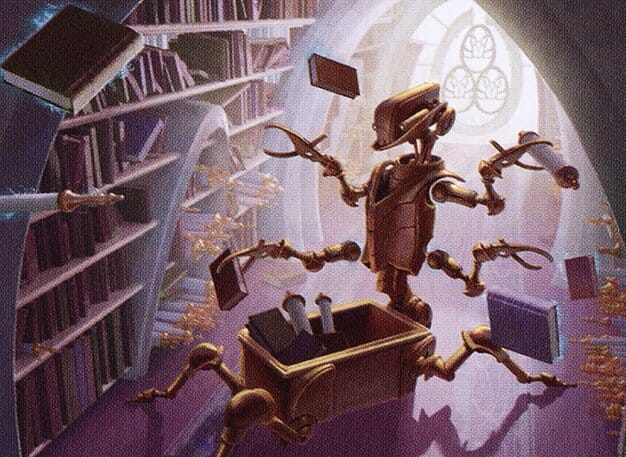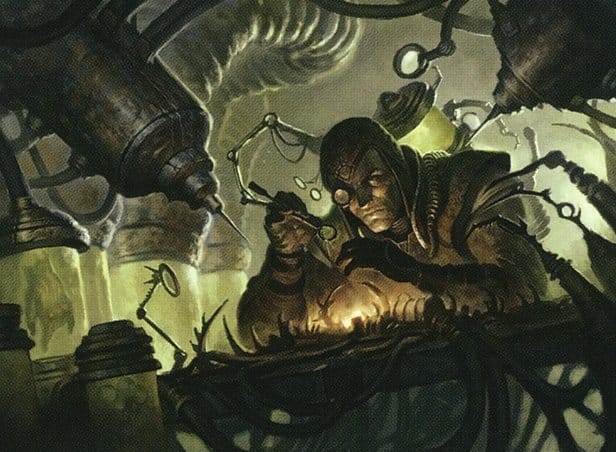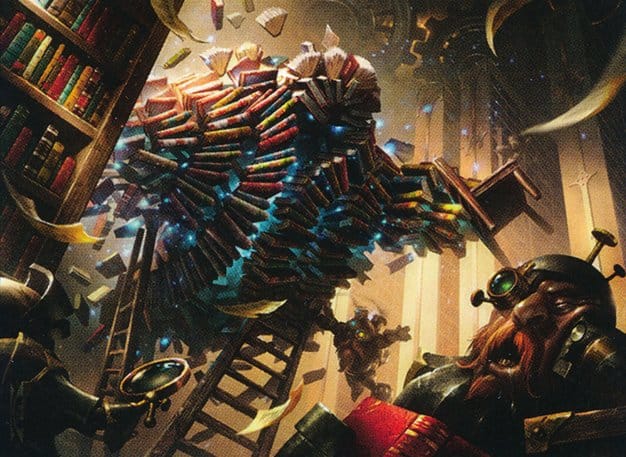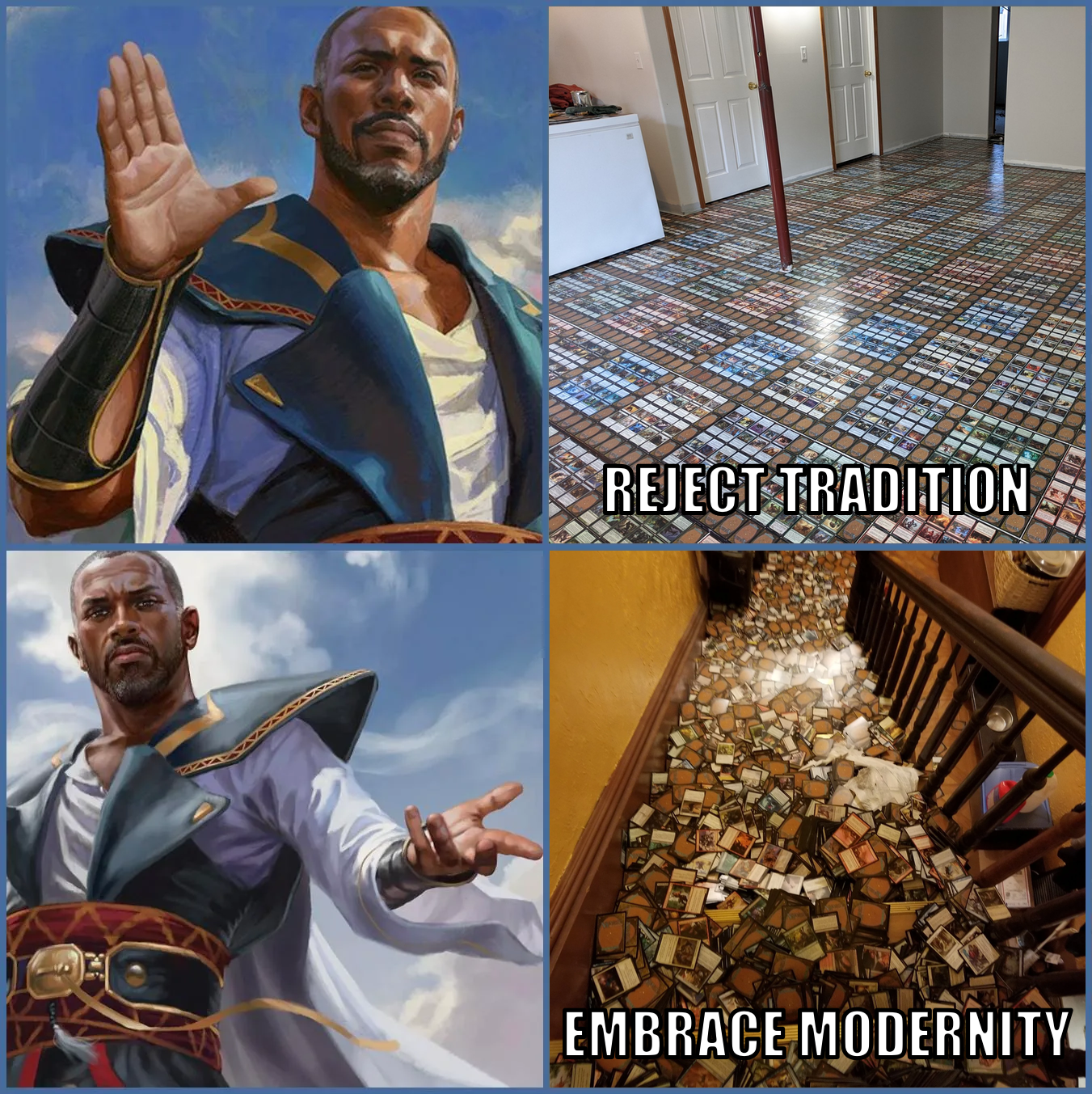If Amazon Ran a TCG Singles Business (Part 4)
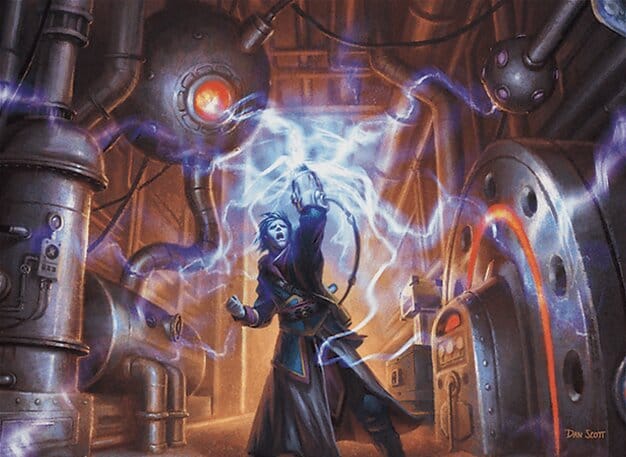
This post is guest written by Jason Garvin from Total Escape Games.
Exploring Chaotic Warehousing for Magic Singles in Practice
Chaotic warehousing is a fascinating idea, and I wanted to explore whether it could work for a local game store.
In this article, I’ll describe our current setup and the bin sorting approach we’re experimenting with. In later articles, I’ll get into the details of the experiments we’ve run to assess the feasibility of the new system.
The Current Setup
Right now, at my store Total Escape Games, we have a library of about half a million cards, all of which are reserved for in-store buying and selling. It’s sorted into three large metal cabinets with drawers that fit four-row BCW boxes, alphabetically by set, and then sorted alphabetically by card title within each set.
We use plastic BCW dividers inside each box to label which set is which and to act as dividers between sets so we can easily tell different sections of the inventory apart.
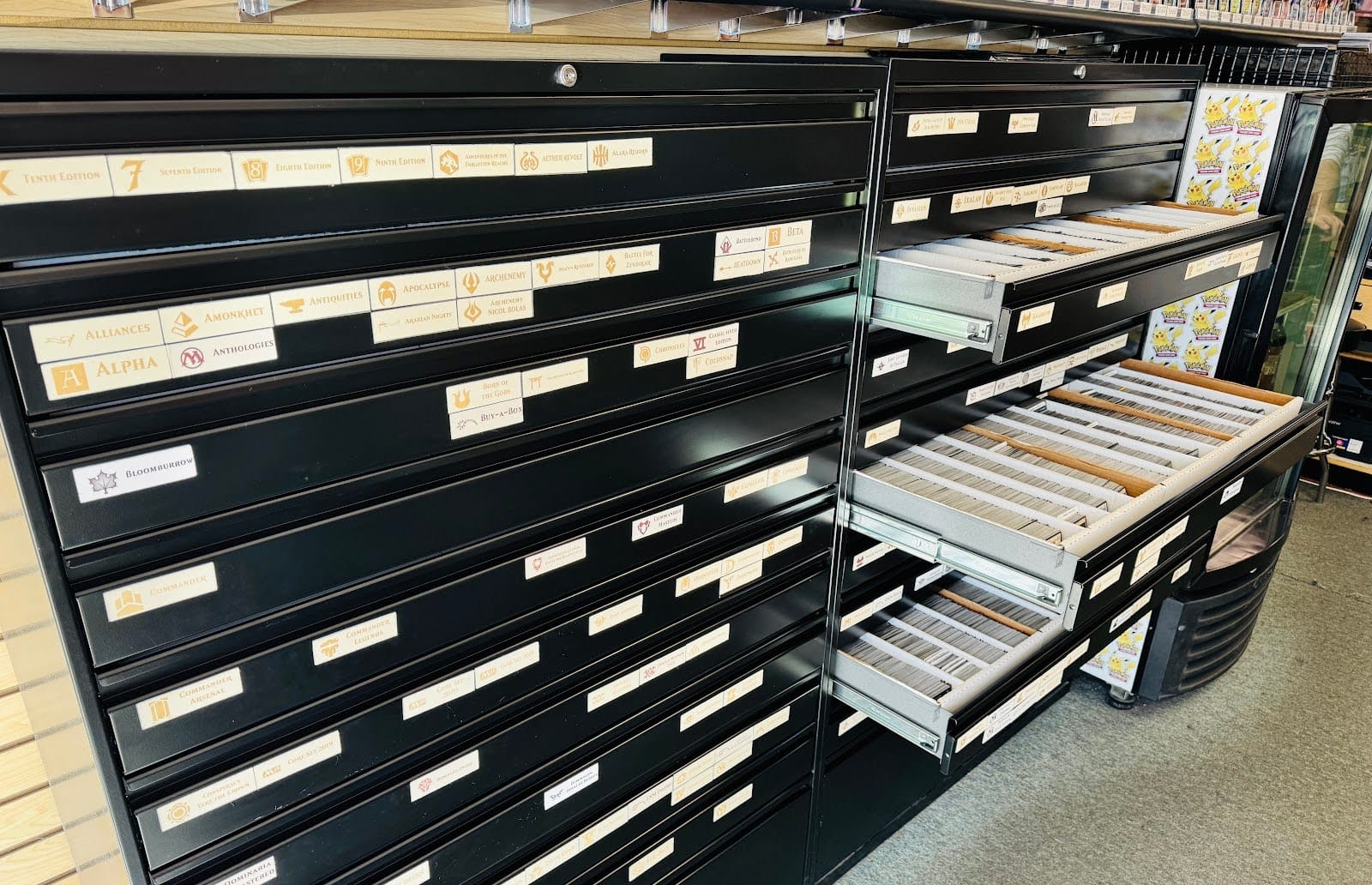
Our current alphabetical sorting method is effective and common. A lot of other stores I know use this same approach, or something similar. It’s predictable, comfortable, and easy to learn.
A huge upside to this kind method is it doesn’t require much knowledge or training – only an understanding of English and the letters in the alphabet. My staff are responsible for a lot of different departments, so anywhere I can make their lives easier is a huge benefit. The fact it’s intuitive even to non-Magic-playing staff is even better.
Problems with Alphabetical Sorting
The flip side is that an alphabetical sorting system can be brutally inefficient, and is difficult to maintain especially as the number of sets and volume of incoming cards increase.
Adding Sets to the Library
Managing the physical space taken up by each set, and preparing space for new sets, is a frustrating part of an alphabetical system. It’s not so bad with a set like Zendikar Rising, but one early in the alphabet like Bloomburrow can force us to rearrange everything if we haven’t planned the space right.
It’s equally awkward when one huge set, or a series of similarly-named sets, become dominant. Every set comes with a “Commander” release, for example, so our Commander section is absolutely massive.
These large sections can span entire drawers, and make managing the space difficult. As the store scales and we open more of each set, it gets more likely we’ll run into this problem, making this problem more common, and more difficult, with time.
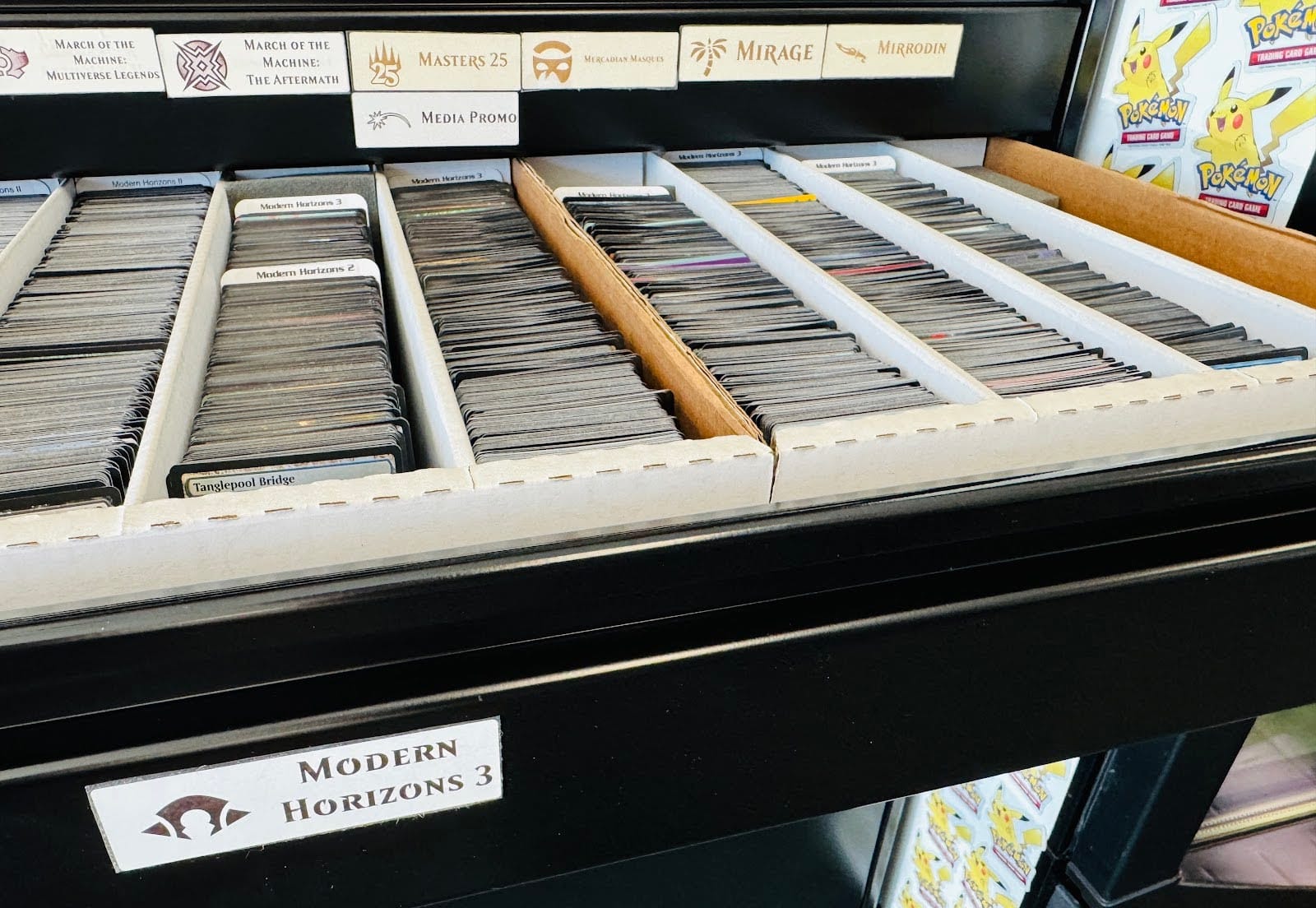
Breaks Down Under High Volume
Getting an influx of buys–sometimes thousands of cards at a time–means managing the singles inventory quickly takes over the focus of the team. I see a lot of room for improvement in our processes, both in getting cards into the inventory faster and also managing the physical stock.
So, we bought a CardBot to help us with sorting and inventorying cards, and along the way I got curious about a different approach: bin sorting.

Bin Sorting Compared to Chaotic Warehousing
In a lot of ways, they’re one and the same.
In chaotic warehousing, everything is stored whenever there’s space, and is then given a unique identifier that tells workers where to find it.
Bin sorting is the same, but instead of storing each individual card where it fits, we group those cards into bins formed of every card that was processed at the same time.
Rather than each card having an exact recorded location, the card is listed within its bin, which can be slotted into any part of the catalog by using a unique identifier that relates to its location.
The cards within each bin are still alphabetically sorted so it’s easy for a member of staff to find what they need, and the bins are kept small so this process is quick.
Essentially, the “bin” becomes the “item” and is then stored in a chaotic warehousing system.
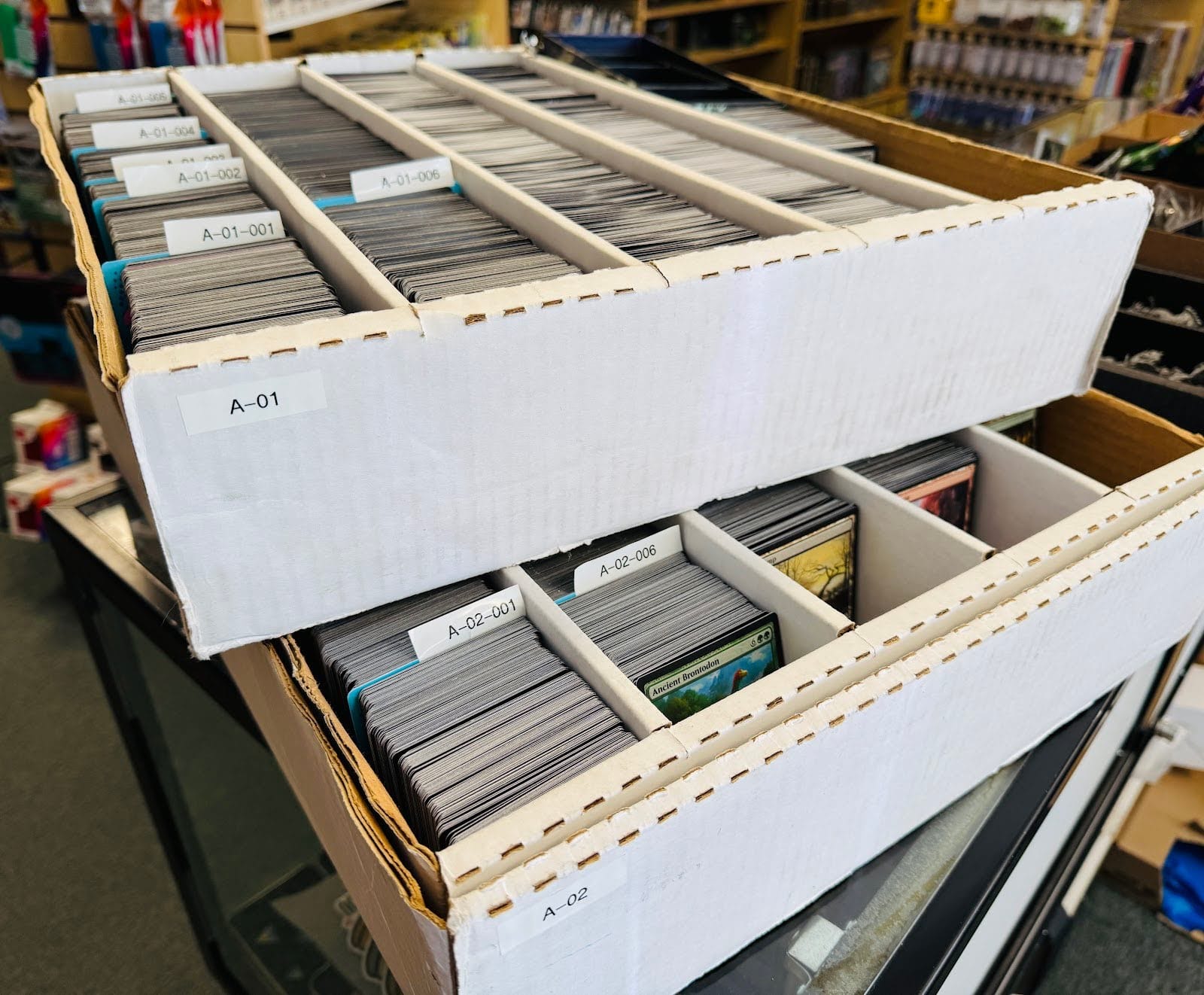
The Trade-offs with Bin Sorting
Overall, I liked my experience trying bin sorting. It solved the major issue we face as a store, which is the time it takes to process and get new stock into the existing library.
I see a lot of potential for this kind of approach, and was pleasantly surprised by how easily it manages expansion, new releases, and library management.
Benefits
The biggest benefit was how much time it saved cataloging and filing new buys into the library. The time it took to process a buy dropped significantly, especially with the help of the CardBot to handle inventorying the cards. We’re talking 3-4 staff hours down to a single hour, most of which is the CardBot running unsupervised.
Being able to take a large buy, split it into bins, then let the robot pluck away before doing a quick sort and adding them to the end of the library felt great.
I saved a ton of time managing the library since I didn’t have to touch the existing inventory to add a bin to the end.
The system easily expands and contracts, and doesn’t fear incoming cards when it comes to ordering and managing inventory. There’s no massive pile of commander sets to sift through. It’s amazingly flexible if there’s software support.
Drawbacks
On the other hand, it was tough managing bin sorting by hand, and there isn’t currently a good software solution, which leads to a rough system prone to failure.
While the tagging feature in CardCastle worked for my small-scale experiment, I fear managing the inventory long-term becomes difficult when I have to manually oversee the tagging system and optimize it by hand. TCGplayer also lacks features to run this kind of system smoothly.
I can code, but I don’t have time to build and bug-test an internal software tool, especially one that has to be user-friendly enough for my nontechnical team to know how to use it in high-pressure situations.
With that in mind, I’ve been really pleased to see what CardCastle has been working on. This article series has taught me a lot about chaotic warehousing, and it sounds like there are some great features coming that will better enable me to use bin-sorting in the future without breaking my back maintaining my own codebase.
Concerns (Assuming Software Support)
Assuming software existed to support bin sorting, my biggest concern becomes training staff to use it and making sure there are fallbacks in place. It’s not as intuitive as alphabetical.
Bin sorting and, by extension, chaotic warehousing are great when the system correctly locates all of the different items. But what happens when a card isn’t where it should be? When an employee pulls and sells the wrong card, forgets to remove a card from inventory, or adds one back that shouldn’t be there?
In an alphabetical system, there may at least be other copies of the card nearby even if one goes missing, but in chaotic warehousing the absence of a single card in its expected bin risks bringing the whole process to a halt.
Maintaining an alphabetical system is simple because the cards are predictably located, and the organization makes sense to a human. Bin sorting, however, takes more attention to detail and strong procedures. I think that should be a goal for every store anyway, but I can see it causing friction in teams not used to operating that tightly, and accidents will always happen.
The Future of Card Management
For bin sorting to work with CCG singles, we need software that manages it for us.
I played with a Python script to simulate the process, and found that a data structure like a queue works pretty well, even with a simple search system, at least on a basic level. But to get any sort of efficiency, and to keep it from exploding at a linear rate when the quantity of cards goes up, someone’s going to have to find a better way.
Amazon has software that runs their warehouses. Robust software that’s trusted by everyone on the team to tell them how to find things, how to adjust inventory when things inevitably get lost, and manages adjustments to the inventory from end to end automatically.
I’d love to see us have something like that for our industry.
Next Steps
Personally, I’m going to continue exploring bin sorting. It addresses the time we spend putting cards away, and gives us the potential to run our singles library more efficiently.
Especially as the volume of work we’re doing increases, I love the idea of reducing the burden on my staff so they can focus on other things. As a full-line game store, I need my team’s attention to be available for other departments besides managing our card library.
I’m not 100% sure bin sorting is the way to go. Pure chaotic warehousing might be better, or it could turn out alphabetical sorting is the go-to of the industry for a reason. Join me in Part 5 of the Chaotic Warehousing series to learn how I implemented my test bin-sorting system, what I’d do differently in the future, and how you can create your own.
In the meantime, if you’ve found a unique and effective way to manage your card game singles, I’d love to hear from you. I think we can agree having better software and tools is a good thing for the industry, and I’m excited to see how my peers and companies like CardCastle innovate in this space going forward!
If you'd like to get in touch with Jason or read more of his writing, head to jasongarvin.com. Stay tuned for Part 5 where Jason will describe his experiments and the details of the system he arrived at.
